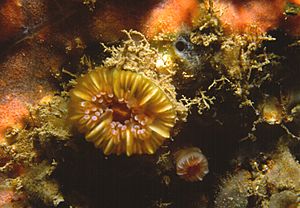Haig Fras facts for kids
Haig Fras is a large, rocky area under the sea. It is about 45 kilometers (28 miles) long. You can find it in the southern part of the Celtic Sea, which is off the coast of southwest England. This special place is about 95 kilometers (59 miles) northwest of the Isles of Scilly. It covers a huge area of about 356.5 square kilometers (137.6 square miles)! At its highest point, Haig Fras comes within 38 meters (125 feet) of the sea surface. It is protected as a Special Area of Conservation (SAC). This is because it is home to many different sea creatures that live on its rocky reefs. Scientists discovered Haig Fras in 1962 and named it in 1965.
The Rocks of Haig Fras
The rocky area of Haig Fras is mostly made of granite. This granite forms a long, stretched-out shape that runs from west-southwest to east-northeast. The granite is surrounded by older rocks that formed during the Devonian and Carboniferous periods. These surrounding rocks are sedimentary rocks, meaning they were made from layers of sand and mud.
Scientists have found that the granite at Haig Fras is about 277 million years old. This makes it from the Early Permian period. This age is similar to the ages of other granite areas in the Cornubian batholith in southwest England. Even though they are similar in age and direction, scientists do not think Haig Fras is directly connected to the Cornubian batholith.
The granite at Haig Fras is fine to medium-grained. This is different from the very large-grained granite often found in the Cornubian batholith. Scientists have also found signs that the granite is cut by many thin, wall-like rock formations called dykes. These dykes are thought to be about 56 kilometers (35 miles) long and 2.5 kilometers (1.6 miles) wide. They likely formed during the Mesozoic Era.
Amazing Sea Creatures
The rocky reefs at Haig Fras are home to many different kinds of sea animals. At the very top of the rocky area, you can find colorful jewel anemones (Corynactis viridis) and beautiful Devonshire cup corals (Caryophyllia smithii).
Near the bottom of the rocky area, you might see sponges that grow in layers, crinoids (which look like feathery plants but are animals), and Ross coral (Pentapora fascialis). Animals that move around a lot are also found here. These include urchins like Echinus esculentus, brittle stars, and the squat lobster Munida.
Why Haig Fras is Protected
Haig Fras is protected as a Special Area of Conservation (SAC). The protected area covers about 481 square kilometers (186 square miles). This area includes a safety zone of about 330 meters (1,080 feet) around the mapped rocky area. This safety zone helps protect the site from damage, especially from certain types of fishing.
The area was first suggested for protection in 2004. It became a candidate SAC in 2008. It was chosen because its rocky reefs are considered a very important habitat under the EU's Habitats Directive. This means it is a special place that needs to be looked after to protect its unique sea life.



